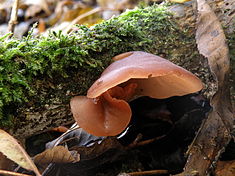Jew's ear
| Auricularia auricula-judae | |
|---|---|
 |
|
| A young specimen growing on fallen wood | |
| Scientific classification | |
| Kingdom: | Fungi |
| Division: | Basidiomycota |
| Class: | Agaricomycetes |
| Order: | Auriculariales |
| Family: | Auriculariaceae |
| Genus: | Auricularia |
| Species: | A. auricula-judae |
| Binomial name | |
|
Auricularia auricula-judae (Bull.) J.Schröt. |
|
| Synonyms | |
|
Species synonymy
|
|
| Nutritional value per 100 g (3.5 oz) | |
|---|---|
| Energy | 284 kcal (1,190 kJ) |
|
0.73 g
|
|
|
9.25 g
|
|
| Minerals | |
| Calcium |
(16%)
159 mg |
| Iron |
(45%)
5.88 mg |
| Phosphorus |
(26%)
184 mg |
|
|
| Percentages are roughly approximated using US recommendations for adults. Source: USDA Nutrient Database |
|
Auricularia auricula-judae, known as the Jew's ear, wood ear, jelly ear or by a number of other common names, is a species of edible Auriculariales fungus found worldwide. The fruiting body is distinguished by its noticeably ear-like shape and brown colouration; it grows upon wood, especially elder. Its specific epithet is derived from the belief that Judas Iscariot hanged himself from an elder tree; the common name "Judas's ear" eventually became "Jew's ear", while today "jelly ear" and other names are sometimes used. The fungus can be found throughout the year in temperate regions worldwide, where it grows upon both dead and living wood.
In the West, A. auricula-judae was used in folk medicine as recently as the 19th century for complaints including sore throats, sore eyes and jaundice, and as an astringent. Although it is not widely consumed in the West, it has long been popular in China, to the extent that Australia exported large volumes to China in the early twentieth century. Today, the fungus is a popular ingredient in many Chinese dishes, such as hot and sour soup, and also used in Chinese medicine. It is also used in Ghana, as a blood tonic. Modern research into possible medical applications has variously concluded that A. auricula-judae has antitumour, hypoglycemic, anticoagulant and cholesterol-lowering properties.
The species was first mentioned in the scientific literature as Tremella auricula by Carl Linnaeus in his 1753 Species Plantarum, and later (1789) described by Jean Baptiste François Pierre Bulliard as Tremella auricula-judae. However, the genus Tremella is now reserved for fungal species that live as parasites on other fungi.Tremella auricula-judae is now considered a basionym. In 1791, Bulliard transferred the species to the genus Peziza. In 1822, Elias Magnus Fries transferred the species to Exidia, and, in so doing, sanctioned the name. In 1860, Miles Joseph Berkeley described the species as a member of Hirneola, a genus described by Fries in 1848, now considered synonymous with Auricularia.
...
Wikipedia
